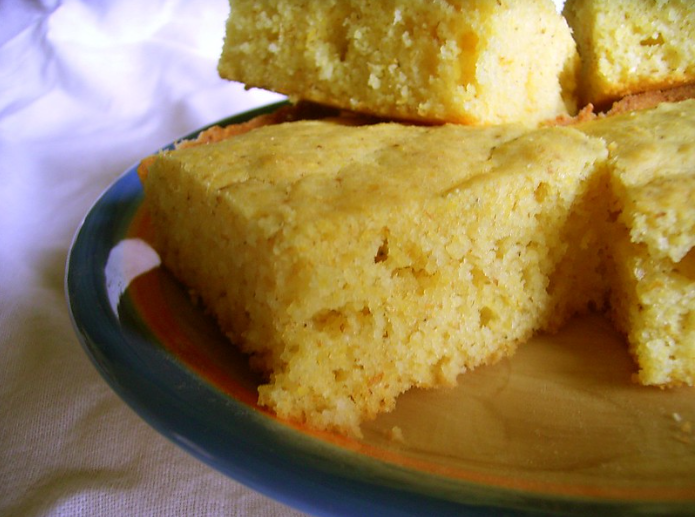My friend’s mother, Miss Sylvia, is making cornbread. Her house is alive with the smell. The 72-year-old woman cooks cornbread the old-fashioned way. An iron skillet in the oven. Lots of butter.
Sylvia tests the hot bread by poking it with a broom bristle. If the bristle is gummy, she licks the bristle and then returns the skillet to the oven. If not, it’s Cornbread-Thirty.
I watch this bristle maneuver. She breaks a piece of straw from her broom. And I don’t want to ask, but I have to.
“Is that broom clean?” I say.
“Relax,” Sylvia says. “It’s just one bristle.”
“But is it clean?”
“Define clean.”
“Has it been used to sweep your floor?”
“This particular broom? Yes.”
“Your dusty, residential, hepatitis-C floor?”
“Yes.”
So this cornbread is contaminated and will probably kill me. But then, I’m a dinner guest, I HAVE to eat it even though the old woman’s floors are frequently used by a family dog who is nicknamed “Egypt” because wherever he goes, he makes little pyramids.
Still, I love cornbread. I was raised on the stuff, just like everyone else in America.
My mother used to make cornbread a few times per week. Sometimes more. Primarily because it was cheap, and my family ate cheap food.
You always knew when it was cornbread night because my mother would make a fresh pot of boiling bacon grease with a few navy beans floating in it. She called it bean and ham soup, but I call it cardiac arrest stew.
Either way, you would use your bread to sop the sides of the bowl. Occasionally, while doing this you would get so giddy that you’d break into song and sing a number from “Oklahoma,” “The Music Man,” or in extreme cases “Jesus Christ Superstar.”
All my life, I considered cornbread to be the fingerprint of a good cook. No two cooks make it alike, and I love that.
The ladies in my childhood church, for instance, made skillet cornbread. The Methodist women across the street made cornbread sticks.
Methodist cornbread sticks were legendary. They were cooked in corn-cob-shaped pans, and crispy on the outside. I would sneak into Methodist church suppers simply to steal cornsticks. At the Methodist door, you had to fill out one of those sticky name tags before they would let you inside. My nametag would usually read:
“HELLO, MY NAME IS: Not Important Because I Am Hungry.”
My wife’s mother makes cornbread with jalapenos and cheese. It is good with a capital “G.” I am prohibited from going anywhere near her cornbread because I can not control myself. This is how I got voted out of the family.
I have eaten cornbread in almost every state in the U.S. In Pennsylvania, it was johnnycakes. And in West Virginia, hot water cornbread.
The cornbread I had in Kentucky was made with pork cracklings and swimming in grease. They called it cracklin’ bread. I called it “Yes please, don’t mind if I do.”
The stuff in New Mexico was served with a bowl of five-alarm chili. This chili was so hot it almost killed me. And I do not mean this figuratively, as in: “Ha ha! That stuff almost killed me!” I mean the waiter went to get a priest.
My Mexican waiter told me to drink a glass of milk to make the burn go away. I drank three glasses. It didn’t help. Finally, the Mexican kid said—and this is a verbatim quote—“You gonna have berry bad toilets in the morning, señor.”
I’m sorry I brought that up.
The cornbread in Texas was ten inches high, like birthday cake, slathered in sweet butter.
The cornbread near Sand Mountain, Alabama, was lace cornbread (hoecake), like pancakes, only with more fundamentalism.
The cornbread I had in South Carolina was crumbled and drowning in a Mason jar of buttermilk. The way I like it.
I ate a cornpone in Virginia that was unlike anything I have ever had. The man prepared it over a campfire. He said his ancestors had been eating this pone for hundreds of years. It looked almost like an English muffin. He served it with whiskey.
And of course, my wife’s cornbread moves me in my deepest parts. Not just because it is perfection, but more importantly because she will probably read this.
When she brings her cornbread to covered dish suppers, it is still in the skillet, piping hot, covered with a dishrag. People usually smile at her cornbread because they know it’s going to be good. You can see it on their faces.
Just like the face I’m wearing right now.
Miss Sylvia brings out plates and one large dish of butter. Her cornbread is soft, tall, and delicate. This cornbread is not just bread. It is her bread. It is made by the hands of a woman who has reared children, packed a million school lunches, given midnight advice around a kitchen table, planned weddings, and prepared the food for her late husband’s funeral.
Her cornbread is everything I love about America, and then some. And even though it is contaminated by a broom bristle, I’ve decided that I don’t think it will kill me.
Which is exactly what I said to myself before I ate that chili.
Sean Dietrich is a columnist and novelist known for his commentary on life in the American South. He has authored nine books and is the creator of the “Sean of the South” blog and podcast. The views and opinions expressed here are those of the author and do not necessarily reflect the policy or position of 1819 News. To comment, please send an email with your name and contact information to Commentary@1819News.com.
Don’t miss out! Subscribe to our newsletter and get our top stories every weekday morning.










